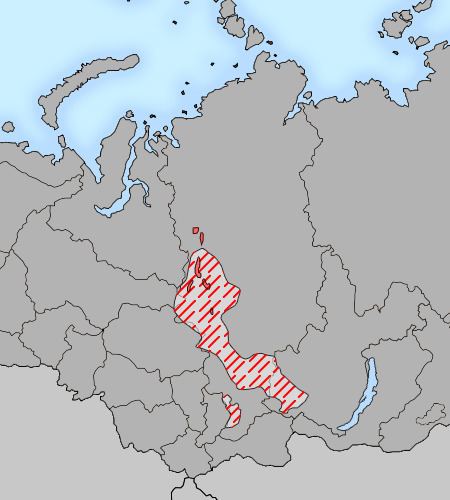Glottolog yeni1252 | ||
 | ||
Geographic
distribution central Yenisei River, Siberia Linguistic classification Dené–Yeniseian?
Yeniseian Subdivisions Northern (Ket–Yugh)
Southern (Arin–Kott) | ||
The Yeniseian languages (lenessian) (sometimes known as Yeniseic or Yenisei-Ostyak; occasionally spelled with -ss-) are a language family whose languages are and were spoken in the Yenisei River region of central Siberia.
Contents
Family division
0. Proto-Yeniseian (before 500 BC; split around 1 AD)
1. Northern Yeniseian (split around 700 AD) 1.1. Ket (200 speakers) 1.2. Yugh † (extinct by 1990) 2. Southern Yeniseian † 2.1. Kott–Assan (split around 1200 AD) 2.2. Arin–Pumpokol (split around 550 AD)Only two languages of this family survived into the 20th century, Ket (also known as Imbat Ket), with around 200 speakers, and Yugh (also known as Sym Ket), which is now extinct. The other known members of this family, Arin, Assan, Pumpokol, and Kott, have been extinct for over two centuries. Other groups – Buklin, Baikot, Yarin, Yastin, Ashkyshtym, and Koibalkyshtym – are identifiable as Yeniseic-speaking from tsarist fur-tax records compiled during the 17th century, but nothing remains of their languages except a few proper names.
It appears from Chinese sources that a Yeniseian group might have been among the peoples that made up the tribal confederation known as the Xiongnu, who have traditionally been considered the ancestors of the Huns, but these suggestions are difficult to substantiate due to the paucity of data. One sentence of the language of the Jie, a Xiongnu tribe who founded the Later Zhao state, appears consistent with being a Yeniseian language.
A proposal connecting Yeniseian to Na-Dené, one of the major language families of indigenous peoples in North America, has been met with a cautious welcome.
Family features
The Yeniseian languages share many contact-induced similarities with the South Siberian Turkic languages, Samoyedic languages, and Evenki. These include long-distance nasal harmony, the development of former affricates to stops, and the use of postpositions or grammatical enclitics as clausal subordinators. Yeniseic nominal enclitics closely approximate the case systems of geographically contiguous families. Despite these similarities, Yeniseian appears to stand out among the languages of Siberia in several typological respects, such as the presence of tone, the prefixing verb inflection, and highly complex morphophonology.
The Yeniseian languages have been described as having up to four tones or no tones at all. The 'tones' are concomitant with glottalization, vowel length, and breathy voice, not unlike the situation reconstructed for Old Chinese before the development of true tones in Chinese. The Yeniseian languages have highly elaborate verbal morphology.
Numerals
The following table exemplifies the basic Yeniseian numerals as well as the various attempts at reconstructing the proto-forms:
A few etymologies
The following table exemplifies a few basic vocabulary items as well as the various attempts at reconstructing the proto-forms:
Proposed relations to other language families
Until 2008, few linguists had accepted connections between Yeniseian and any other language family, though distant connections have been proposed with most of the ergative languages of Eurasia.
Dené–Yenisean
In 2008, Edward Vajda of Western Washington University presented evidence for a genealogical relation between the Yeneisian languages of Siberia and the Na–Dené languages of North America. At the time of publication (2010), Vajda's proposals had been favorably reviewed by several specialists of Na-Dené and Yeniseian languages—although at times with caution—including Michael Krauss, Jeff Leer, James Kari, and Heinrich Werner, as well as a number of other respected linguists, such as Bernard Comrie, Johanna Nichols, Victor Golla, Michael Fortescue, Eric Hamp, and Bill Poser (Kari and Potter 2010:12). One significant exception is the critical review of the volume of collected papers by Lyle Campbell and a response by Vajda published in late 2011 that clearly indicate the proposal is not completely settled at the present time. Two other reviews and notices of the volume appeared in 2011 by Keren Rice and Jared Diamond.
Karasuk
The Karasuk hypothesis, linking Yeniseian to Burushaski, has been proposed by several scholars, notably by A.P. Dulson and V.N. Toporov. George van Driem, the most prominent current advocate of the Karasuk hypothesis, postulates that the Burusho people were part of the migration out of Central Asia that resulted in the Indo-European conquest of the Indus Valley.
Sino-Tibetan
As noted by Tailleur and Werner, some of the earliest proposals of genetic relations of Yeniseian, by M.A. Castrén (1856), James Byrne (1892), and G.J. Ramstedt (1907), suggested that Yeniseian was a northern relative of the Sino-Tibetan languages. These ideas were followed much later by Kai Donner and Karl Bouda. In more-recent studies at the beginning of the 21st century, historical linguist Edward Vajda (who also proposes the Dené–Yenisean relationship) had spent a year studying the Ket people's Yeniseian, where his findings helped with the substantiation of this conjecture into the origins of Ket people, and DNA claims showing genetic and linguistic affinities with such ethnic groups living in relatively close-proximity to the region of Tibet (vis-a-vis Sino-Tibetan and Tibeto-Burman)[1]; he further suggests that the tonal system of the Ket language is closer than that of spoken Vietnamese than the other native languages found in Siberia [2].
Dené–Caucasian
Bouda, in various publications in the 1930s through the 1950s, described a linguistic network that (besides Yeniseian and Sino-Tibetan) also included Caucasian, and Burushaski, some forms of which have gone by the name of Sino-Caucasian. The works of R. Bleichsteiner and O.G. Tailleur, the late Sergei A. Starostin and Sergei L. Nikolayev have sought to confirm these connections. Others who have developed the hypothesis, often expanded to Dené–Caucasian, include J.D. Bengtson, V. Blažek, J.H. Greenberg (with M. Ruhlen), and M. Ruhlen. George Starostin continues his father's work in Yeniseian, Sino-Caucasian and other fields.
